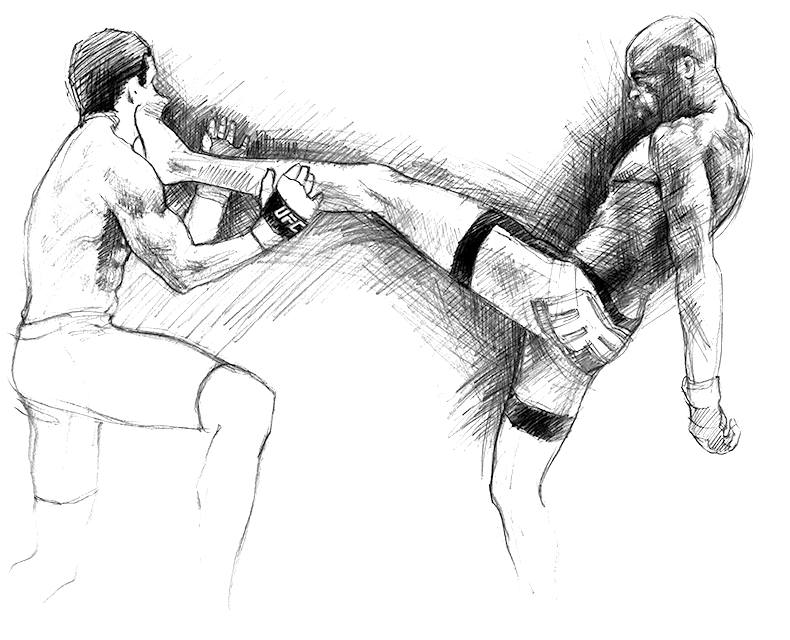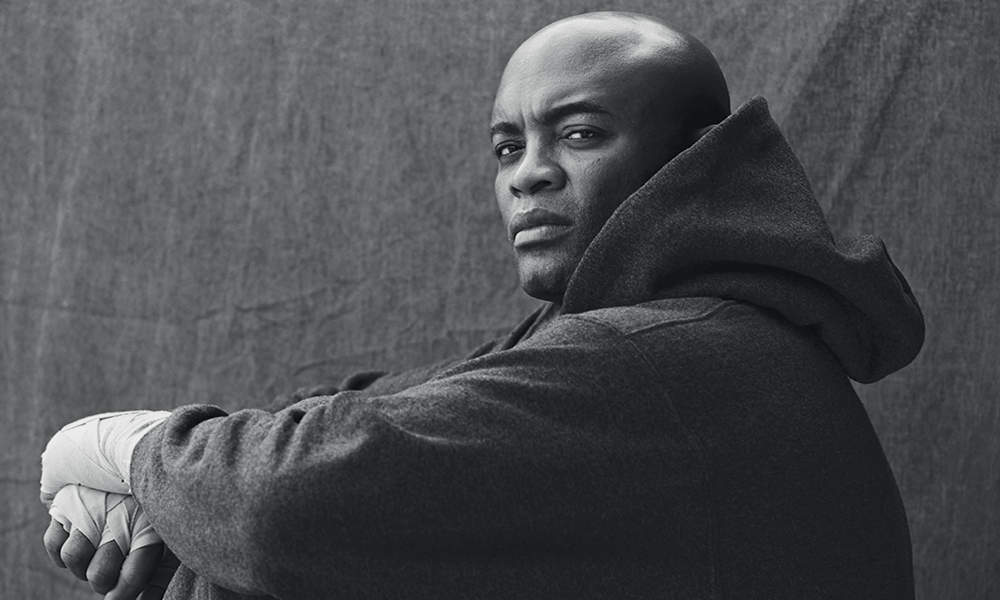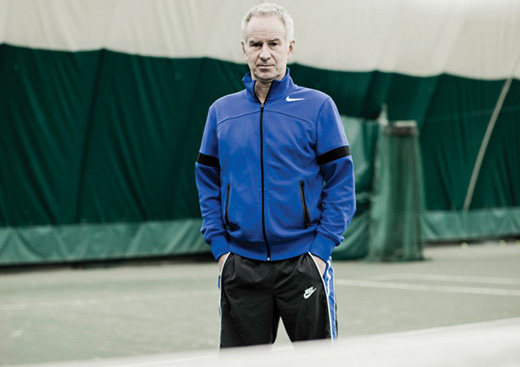The video went viral. “Anderson Silva’s leg wraps around Chris Weidman’s waist like a piece of spaghetti!” exclaimed a journalist for ESPN the day after 38-year-old Brazilian UFC champion Anderson Silva broke his leg dramatically in a fight against New York-born Weidman, a fighter nine years his junior. It’s impossible to watch Silva kick at Weidman then fall back without cringing, and equally impossible to imagine the pain. In the footage from that night, December 28, 2013, in Las Vegas, the fighter’s leg does indeed wrap unnaturally and limply around his opponent’s torso. Those standing or sitting cage-side heard a cracking sound.
“I don’t remember much about fights,” Silva says in retrospect. “It happens very fast. But this match, when I suffered the injury, I remember certain things perfectly.”
The fighter, who was born into poverty in Curitiba, Brazil, and initially learned martial arts by watching neighbor kids who could afford lessons, heard the cracking sound, too.
“I was preoccupied with holding my leg, but I held it in a lot of pain,” he remembers, “and my trainer, Rogério Camões, and Ed Soares, my manager, came. When they allowed my manager in, I still remember I said: ‘Boss, why did God allow this to happen to me? Why did God do this to me?’ In that moment, I thought it was all over. I was in a state of shock. I was worried about my family. I was worried about my leg, if I would walk again, train again, if I could fight again. A thousand things came to mind.”
Silva would be carted off that night on a stretcher and have emergency surgery to repair the tibia and reset the fibula in his left leg. Later, it took nearly six months for him to recover, he would wonder if God had indeed been trying to tell him something that night. Was it time for him to slow down?
Silva is 6-foot-2 and stoic with a square jaw and a defined, serious brow. Before his fateful fight against Weidman, The Spider, as he is often called, had gone undefeated for seven years, winning 16 consecutive fights and defending his UFC Middleweight Champion title a record 10 times. He had defeated one great fighter after the next, including Forrest Griffin, Chael Sonnen, Vitor Belfort and Dan Henderson. He could beat his rivals at their own games, and he was starting to seem unstoppable. “There have been plenty of moments in The Spider’s career that have already cemented him as the best of all time,” wrote Adam Hill for Bleacher Report in spring 2013.
But six months before his potentially career-ending fight, Silva had faced Weidman at MGM Grand Garden Arena for UFC 162, a middleweight championship fight, and lost his title.
“I lost the first time due to lack of focus,” he says in retrospect, and the reasons for that lack of focus ran deep: “Because I was thinking of other things, because I was unhappy with myself within what I was doing in my sport and disappointed even with the organizers of fighting, and the downfalls of celebrity and fighting itself.”
A few months later, as he geared up for his December rematch with Weidman, he had regained his composure, calmed his self-questioning.
“The second fight, I was completely ready for,” he says. Then his leg broke, dramatically and severely. “God gave me a signal there: ‘Dude, you gotta stop. You have to stop. I gave you a sign; you didn’t understand…’ But more than that, it was about being able to see yourself, to see yourself, which is very hard, and realize, ‘Darn, I’ve been doing everything wrong.’ ”
That’s what he had time to think about as he began his slow, multi-month recovery, going from lying on his back to using crutches to limping. The pressure of being and staying a champion had distracted him. “I didn’t have time to live my life, my reality, which was to be with my kids, to be with my family,” he says. The push—traveling to promote the fights, handling the back talk and insults opponents throw at each other, talking to journalists, playing the champion—had been wearing on him.

“People don’t care if you’re injured, if your head is in the right place,” he says. “They want you to make it happen; the show must go on, and it has to be real. But this isn’t real. For me, it was never real. The system takes away the truth from you, takes fighting away from you as something you love.”
Silva, who had an obsession with superheroes as a child and began learning martial arts first through magazines and then by hanging around neighbor kids who trained in Tae Kwon Do, lived with his aunt and uncle for much of his childhood—his parents had been unable to afford his upbringing. During his middle-school years, he used to slip into a local Tae Kwon Do gym just to watch the kids in white uniforms train. After a while, an instructor who had noticed him lurking offered to teach him if he agreed to clean the gym in exchange. In high school, he took the same approach again, lingering around a nearby Muay Thai gym that he had to pass each day to and from home. That’s how he met his first trainer, Edmar. “Do you train in Muay Thai?” Edmar asked him one day when Silva was standing outside. “I train in Tae Kwon Do,” Silva answered. “Come over and I’ll train you,” Edmar said. Silva did, and stayed at that gym until he’d become a mixed martial arts phenomenon. The physical prowess, elation and magic that came with being a skilled fighter was probably as close as he could get in real life to the Spiderman and Superman fantasies he entertained as a child.
The fighter stayed in São Paulo until 2007, when his success in MMA made it financially possible, and also perhaps necessary, for him to move to the U.S. In Brazil he had been driving around in an armored car and worried about the safety of his family. He has five children, three in the U.S. now and two in Brazil.
So he was in Los Angeles during his long, self-reflective recovery. Friendship, family, children, legacy: Those were the things he thought about most often, he says now. “One fight or two can’t define the human being, or the man,” he explains. “What defines you is your attitude as a friend, as a brother, as a father, as a son, as a citizen. This, yes, defines me as a person.” But watching his children at sports practice, running, jumping and
making plans for their futures, the fighter began to itch to return to his own love. “I still don’t know if I’m ready and if I can do what I did with such excellence before,” he says, though the apprehension wasn’t great enough to keep him from trying.
In the summer of 2014, speculation that Silva would return began circulating in MMA press. When he announced he would be facing Nick Diaz in January 2015, MMA Junkie referred to him as an “ex-champion” who, it was “safe to say,” was “returning with a bit more humility.” Silva won that fight against Diaz.
It wasn’t the same, though. He was the older, once-defeated fighter making a comeback.
“This thing, being a champion,” he says, “I can’t say that I don’t miss it sometimes… but when I started fighting, you just went there, fought, won if you won. Tomorrow it was all over, water under the bridge. All the victories I always had, the successful results I obtained, were always based on this: I go there, I fight, it’s over. I win, it’s over. I lift my arm, I go home. I lift my arm, it’s over. And then back to the start again.”
—





